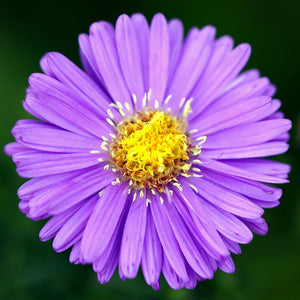The Aster Guide
Asters are hardy, late-season perennials that bring vibrant color to gardens when many other plants have finished blooming. With daisy-like flowers in shades of purple, pink, blue, and white, Asters attract pollinators and add a burst of beauty to autumn landscapes. These versatile plants thrive in borders, meadows, and native plant gardens, offering long-lasting seasonal interest. Here’s everything you need to know about growing and caring for Asters.

About
Asters belong to the Asteraceae family and are native to North America, Europe, and Asia. These perennials are known for their profuse blooming habit, producing star-shaped flowers that create a stunning display from late summer into fall. They are a valuable nectar source for pollinators, particularly butterflies and bees, as they bloom when few other plants are in flower.
Popular varieties include Aster novae-angliae 'Alma Potschke', a striking pink New England Aster; Aster x frikartii 'Monch', which produces lavender-blue blooms over an extended season; and Aster oblongifolius 'Raydon’s Favorite', known for its aromatic foliage and deep purple flowers. Low-growing varieties like Aster ericoides 'Snow Flurry' create a dense carpet of blooms, while tall selections such as Aster laevis 'Bluebird' add vertical interest to garden beds.
Asters are adaptable and resilient, thriving in full sun and well-drained soil. They are excellent for naturalizing and work well in wildlife-friendly gardens, mixed borders, and cottage-style plantings.

PLANTING
- USDA Hardiness Zones: Most Asters grow well in Zones 3-8, depending on the species.
- Soil: Prefers well-drained, moderately fertile soil. Adding compost improves soil structure and enhances bloom production.
- Sunlight: Full sun is ideal for most Asters, though some species tolerate partial shade.
- Watering: Requires regular watering during establishment; mature plants are somewhat drought-tolerant but perform best with consistent moisture.
- Spacing: Space plants 12-36 inches apart, depending on the variety, to allow good air circulation.
- Planting Time: Seeds - Sow in early spring or fall, lightly covering them with soil. Transplants - Plant in spring or early fall to allow roots to establish before extreme weather conditions.
To plant Asters, loosen the soil, mix in organic matter, and place plants at the same depth as in their containers. Water thoroughly after planting.

CARE
- Watering: Keep soil evenly moist, particularly during dry periods, but avoid overwatering, which can lead to root rot.
- Fertilizing: Apply a balanced fertilizer in early spring to encourage strong growth and abundant blooms.
- Pruning: Pinch back stems in late spring or early summer to encourage bushier growth and prevent legginess. Deadhead spent flowers to prolong blooming.
- Pests & Diseases: Susceptible to powdery mildew, particularly in humid conditions. Ensure good air circulation and avoid overhead watering.
- Dividing: Divide Aster clumps every 2-3 years in early spring or fall to maintain vigor and prevent overcrowding.

HOW TO USE
Asters’ late-season blooms and adaptability make them an excellent choice for various garden settings:
- Pollinator Gardens: A vital nectar source for butterflies, bees, and other beneficial insects.
- Meadow & Prairie Gardens: Pairs well with goldenrod, echinacea, and ornamental grasses.
- Borders & Edging: Compact varieties like Aster dumosus 'Wood's Blue' create colorful edging along paths and flower beds.
- Wildlife-Friendly Landscapes: Provides late-season food for pollinators and seed heads for birds in winter.
- Cut Flower Gardens: Long-lasting flowers make Asters excellent additions to floral arrangements.

Common Questions
- What does an Aster flower look like? Aster flowers have a daisy-like shape with a central yellow disk surrounded by colorful ray petals in shades of purple, pink, blue, or white.
- Are Asters perennial plants? Yes, most Aster species are perennials that return each year.
- Do deer eat Aster plants? Asters are somewhat deer-resistant, though deer may browse them occasionally in times of scarcity.
- When to plant Asters? Plant in spring or early fall to establish strong root systems.
- How to care for Aster plants? Provide full sun, well-draining soil, regular watering, and occasional pruning to encourage bushier growth.
- Are Asters toxic for dogs? No, Asters are non-toxic to dogs and safe for pet-friendly gardens.
- Are Asters toxic for cats? No, Asters are not toxic to cats and can be grown in households with pets.
- Do deer eat Asters? While not their first choice, deer may occasionally nibble on Asters if other food sources are unavailable.
Conclusion
Asters are vibrant, late-season perennials that bring long-lasting color and ecological benefits to the garden. Their daisy-like blooms provide a crucial nectar source for pollinators while adding charm and texture to landscapes. Whether you choose Aster novae-angliae 'Purple Dome', Aster oblongifolius 'October Skies', or Aster x frikartii 'Monch', there’s an Aster variety suited for every garden. Explore our collection and enjoy the beauty of Asters in your outdoor space.
The Aster Collection
Sold Out
Sold Out
Sold Out
Sold Out
Sold Out






